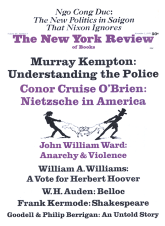In response to:
Up from Ultraism from the August 13, 1970 issue
To the Editors:
Near the end of his admirable article “Up from Ultraism” (New York Review, August 13), Jorge Luis Borges expresses dissatisfaction with Góngora’s line “en campos de zafiro pace estrellas.” The root of the difficulty lies, I am persuaded, in accepting “sapphire” as the meaning of zafiro. I believe that Góngora was using the word in its ancient, classical sense of “lapis lazuli.” (See, for instance, A. Bailly, Dictionnaire Grec Français [Paris, 1950], which defines $$$ as “lapis lazuli.”) The aptness of lapis lazuli (cf. our cognate word “azure”) as a sky-image is not merely because the mineral is a fine shade of blue, but because the best specimens are sprinkled with golden flecks of pyrite, like shining stars in the dark blue firmament.
The “sapphire” (Hebrew sappir) of the Bible is lapis lazuli. So also is the “sapphire” of the early minerologists. Theophrastus, On Stones, IV, 23, has: $$$ (translated by D. E. Eichholz, Theophrastus, De Lapidibus [Oxford, 1965], p. 65: “the sapphirus, which is speckled as if with gold”). Or consider Pliny: “…for the Saphire also glittereth with markes and prickes of gold” (translation by Philemon Holland, Historie of the World [London, 1601], p. 620). This, too, refers to lapis lazuli. The usage did not die out in Europe. It has been noted that the word sapphiros was still employed in the sense of “lapis lazuli” in the middle of the sixteenth century by the mining engineer Agricola (cf. Sydney H. Ball, A Roman Book on Precious Stones [Los Angeles, 1950], p. 291). Although I am not familiar with the context of Góngora’s line, I find the image precise and therefore splendid. This notable bull would surely find an abundance of stars in his “sapphire” pasture. His field was, in the language of heraldry, Azure, semé of estoiles Or.
Edward H. Schafer
Professor of Oriental Languages
University of California, Berkeley
Jorge Luis Borges replies:
I want to thank Professor Schafer for pointing out to me that the sapphire is the lapis lazuli of the ancient world. No doubt Góngora was using the word in this sense and, torn from its context, his line is a fine one. The beginning of his stanza, however, runs thus:
Era del año la estación florida
en que el mentido robador de Europa
—media luna las armas de su frente,
y el Sol todos los rayos de su pelo—, luciente honor del cielo,
en campos de zafiro pace estrellas….[It was the flowering season of the year when Europa’s false thief—a halfmoon the weapons of his forehead, and the Sun all the rays of his hide—shining honor of the sky, in sapphire fields grazes on stars….]
My feeling is that in these lines the sapphire is merely an afterthought, cribbed from Dante, and that Góngora seems to be far more interested throughout the six ornate verses in the celestial bull’s running at large. What stands out in Dante, by contrast, is the sapphire hue of the dawn, pure and unencumbered by the Animal Kingdom.
By the way, we also read this of the bull in Quevedo’s Epístola satírica y censoria:
Un animal a la labor nacido,
y símbolo celoso a los mortales,
que a Jove fue disfraz, y fue vestido;que un tiempo endureció manos reales,
y detrás de él los cónsules gimieron,
y rumia luz en campos celestiales….[A beast born to labor and an envied symbol to mortal man, that to Jove was a disguise and a costume; that once hardened the hands of kings and behind it consuls toiled and it chews light in celestial fields….]
This Issue
November 5, 1970



